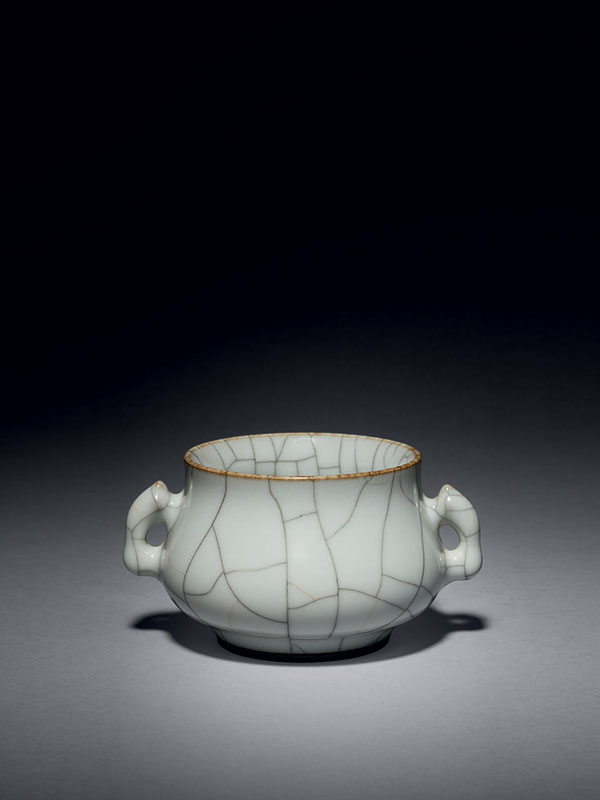Ge-type porcelain censer
A porcelain incense burner of archaic gui form, supported on a short foot. The round sides curve in towards the rim. Two halberd-shaped handles are attached to the sides of the body. The censer is covered in a thick greyish blue glaze suffused with a network of black and faint russet crackle. Around the rim, where the glaze is thin, a russet colour is applied. The glaze stops neatly above the foot, revealing the dark, brownish body. The glazed base has three nail-like spur marks around the edge.
The original Ge ware is historically considered one of the ‘five famous kilns’ of the Song dynasty (960 – 1279) together with Ding, Jun, Ru and Guan, as identified by early Ming scholars.[1] Ge ware typically exhibits a thin body in dark clay, covered with a thick greyish-blue glaze, fully opaque with an almost matte finish. The glaze tends to be thin at the mouth, so that the lip appears dark; iron compounds in the exposed body clay of the foot fire a purplish–rust colour. These features are traditionally described together as ‘purple rim and iron foot’.[2] Another main feature of Ge wares, known as ‘golden thread and iron line’, describes the two different colours of the crackle. The taste for Ge ware continued into the Qing dynasty, when old pieces were collected and new ones created. Stained crackle-glazed wares of Ge-type were made at Jingdezhen from the Chenghua period (1465 – 1487) onwards. The deliberately discoloured porcelains had iron pigments painted onto the foot and rim to satisfy the ‘purple rim and iron foot’ criteria. During the Qing dynasty, Jingdezhen copies of Ge ware were made with a high alumina, lime-alkali glaze, making them close to the original Song examples. The body is true stoneware that contains iron oxides and a low silica content that encourages crazing.[3] Two Song dynasty Ge censers of comparable size and glaze from the Qing court collection are in the Palace Museum, Beijing.[4] A further comparable Ge-type censer, dated to the Ming dynasty and with a similar ‘golden thread and iron line’ crackle, is in the collection of the National Palace Museum, Taipei.[5]
1 Wood, N. Chinese Glazes- Their Origins, Chemistry and Recreation, A&C Black, London, P.87
2 Li, Chu-Tsing and Watt, J. ed. The Chinese Scholar’s Studio- Artistic Life in the Late Ming Period, Thames and Hudson, New York, 1987, p. 164
3 Wood, Nigel, op. cit. pp. 87-88
4 Li, Huibing ed. Liang Song Ci Qi, vol.II- Gugong bowuyuan cang wenwu zhenpin quaji, Shangwu yinshuguan, Hong Kong, nos. 46, 52, pp. 52, 58
5 Chen, C. K. A Special Exhibition of Incense Burners and Perfumers Throughout the Dynasties, The National Palace Museum, Taipei, 1994, no. 32, p. 176
仿哥窯戟耳爐
清 十八世紀
寬:10.5 公分 徑:6.5 公分 高:5.6 公分
仿哥窯戟耳爐,侈口,短頸,圓碩腹,矮圈足,頸腹兩側各飾一戟形耳,通體素面無飾,胎骨較厚, 施仿哥釉,呈色月白偏灰,釉色光亮瑩潤,口沿釉薄處現出棕灰色邊,圈足施釉不勻整,著地處顯露 出深灰色的胎體,形成“紫口鐵足”; 釉面布滿大小紋片,縱橫交織,開片深淺不一,形成“金絲鐵 線”。採支、墊結合方式裝燒,器底有三道芝麻丁痕。整器小巧秀美,古拙而不失俊美。哥窯是宋代 著名窯場,以其開片帶有“金絲鐵線”聞名。宋代哥窯在後世備受人們青睞,元明清仿制者頗多,且 各有風格,被稱為仿哥窯或哥釉。本品胎釉均著意模仿傳世哥窯,極富凝重古樸之感,釉面渾厚滋 潤,釉色均勻,是清仿燒瓷佳作。傳世宋代哥窯耳爐極為珍稀,可見於北京故宮博物院 ; 明代仿哥窯耳 爐則藏於臺北國立故宮博物院。

